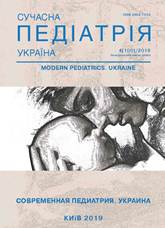Diagnostic information of clinical markers in the verification of acute infectious-inflammatory processes of the lower respiratory tract in children
Abstract
Objective. To study the clinical features of the course of community-acquired pneumonia and acute obstructive bronchitis in children of different ages in order to optimize the treatment of the acute pathology of the respiratory system.
Materials and methods. А cohort of patients with acute respiratory pathology of children with different ages (75 patients) who received inpatient treatment has been formed by the method of simple random sampling. The first (I) clinical group was formed by 51 patients with a verified diagnosis of community-acquired pneumonia, acute course, and the second (II) clinical group included 24 children, in which the infiltrative acute process in the lungs was excluded, that is, with manifestations of broncho-obstructive syndrome (BOS). According to the main clinical characteristics, the comparison groups have been comparable. The results of the study have been analyzed by parametric and non-parametric calculation methods, and the evaluation of the diagnostic value of the tests has been performed taking into account their sensitivity (Se) and specificity (Sp) from the perspective of clinical epidemiology.
Results. The analysis of the main symptoms and signs that troubled the hospitalized patients has showed that the most frequent complaints in patients with community-acquired pneumonia (CAP) were cough (100%), fever (84,3%) and signs of intoxication (90.2%), which only in every second child (45.1%) were combined with shortness of breath. At the same time, the leading combination of complaints in children with BOS were cough (100% of cases) and dyspnea (83.3% of observations), but often in combination with symptoms of intoxication (70.8% of people) and hyperthermia (in 66.7% of children). The analysis of auscultative changes above the pulmonary fields has showed the asymmetry of auscultative phenomena in majority (90.3% of children) of patients with CAP and in 16.7% of cases in the II group of (P<0,001). At the same time, the persistence of asymmetrycal auscultatory changes in the dynamics of observation for >2 days has been observed in 90.2% of cases in I group and only in 12.5% patients with BOS (P<0,001). There has been recorded the following auscultational symptoms in patients with BOS: weakened breathing diminished breath sounds above both pulmonary fields in every fifth (20.8%) patient, the presence of bilateral (without asymmetricity) crepitation/fine bubbling rales — in 12.5% of subjects. Whistling dry rales without there specific localization have been heard in all patients with BOS but in half (52.9%) patients with pneumonia (P<0.001).
Conclusion. In detecting pneumonia in children the most sensitive signs were the symptoms' complex combining cough, hyperthermia and/or intoxication, or a combination of cough with symptoms of intoxication and respiratory failure, but the most specific clinical signs were asymmetric dullness on lung percussion and combination of asymmetric diminished breath sounds with focal crepitation/fine bubbling rales which are persisting several days against the background of the initial empirical antibiotic therapy. The most significant signs of acute obstructive bronchitis in children were: the combination of normothermia with cough, wheezing, and expiratory dyspnea, and the absence of asymmetry of percussion and auscultatory phenomena along of signs of chest distention and bandbox percussion sound during examination of the chest, which, in general, are constitute sufficient grounds for patients' assigning of desobstructive therapy.
References
Dona D, Zingarella S, Gastaldi A, Lundin R et al. (2018). Effects of clinical pathway implementation on antibiotic prescriptions for pediatric community-acquired pneumonia.PLОS ONE. 13(2): e0193581. https://doi.org/10.1371/journal.pone.0193581; PMid:29489898 PMCid:PMC5831636
Evertsena J, Baumgardnera DJ, Regnerya A, Banerjeeb I. Diagnosis and management of pneumonia and bronchitis in outpatient primary care practices. (2010). Prim Care Respir J. 19(3): 237–241. https://doi.org/10.4104/pcrj.2010.00024; PMid:20490437 PMCid:PMC3065928
Kinkade S, Long NA. (2016). Acute Bronchitis. Am Family Physician. 94 (7): 560–6. http://www.aafp.org/afp/2016/1001/p5604s1.
Kochling A, Loffler C, Reinsch S, Hornung A et al. (2018). Reduction of antibiotic prescriptions for acute respiratory tract infections in primary care: a systematic review. Implementation Science. 13(47): 1–25. https://doi.org/10.1186/s13012-018-0732-y; PMid:29554972 PMCid:PMC5859410
Mathura S, Fuchsb A, Bielickia J, Van Den Ankerb J, Sharlanda M. (2018). Antibiotic use for community-acquired pneumonia in neonates and children: WHO evidence review. Paediatrics and International Child Health. 38 (S1): 66–75. https://doi.org/10.1080/20469047.2017.1409455; PMid:29790844 PMCid:PMC6176769
May GSJ, Nkwopara E, Ambler G, McCollum ED et al. (2018). Methods for conducting a double-blind randomized controlled clinical trial of three days versus five days of amoxicillin dispersible tablets for chest indrawing childhood pneumonia among children two to 59 months of age in Lilongwe, Malawi: a study protocol. BMC Infectious Diseases. 18: 476–486. https://doi.org/10.1186/s12879-018-3379-z; PMid:30241517 PMCid:PMC6151015
Pietro P, Alberighi ODC, Silvestri M, Tosca MA et al. (2017). Monitoring adherence to guidelines of antibiotic use in pediatric pneumonia: the MAREA study. Italian J. of Pediatrics. 43: 113–26. https://doi.org/10.1186/s13052-017-0432-2; PMid:29273072 PMCid:PMC5741879
Rodrigues CMC, Grovesc H. (2018). Community-Acquired Pneumonia in Children: the Challenges of Microbiological Diagnosis. J. Clin Microbiol. 56 (3): 1318427. https://doi.org/10.1128/JCM.01318-17; PMid:29237789 PMCid:PMC5824044
Sausta LT, Bjerrumb L, Siersmab V, Arpia M, Hansenc MP. (2018). Quality assessment in general practice: diagnosis and antibiotic treatment of acute respiratory tract infections. Scandinavian J. Primary Health Care. 36(4): 372–379. https://doi.org/10.1080/02813432.2018.1523996; PMid:30296885 PMCid:PMC6381521
Singh A, Zahn E. Acute Bronchitis. Affiliations: UConn/Hartford Hospital (Last Update: March 22, 2019). https://www.ncbi.nlm.nih.gov/books/NBK448067/
Downloads
Issue
Section
License
The policy of the Journal “MODERN PEDIATRICS. UKRAINE” is compatible with the vast majority of funders' of open access and self-archiving policies. The journal provides immediate open access route being convinced that everyone – not only scientists - can benefit from research results, and publishes articles exclusively under open access distribution, with a Creative Commons Attribution-Noncommercial 4.0 international license (СС BY-NC).
Authors transfer the copyright to the Journal “MODERN PEDIATRICS. UKRAINE” when the manuscript is accepted for publication. Authors declare that this manuscript has not been published nor is under simultaneous consideration for publication elsewhere. After publication, the articles become freely available on-line to the public.
Readers have the right to use, distribute, and reproduce articles in any medium, provided the articles and the journal are properly cited.
The use of published materials for commercial purposes is strongly prohibited.

